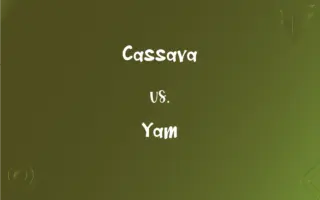Batter vs. Dough: What's the Difference?
Edited by Aimie Carlson || By Janet White || Published on November 22, 2023
Batter is a liquid mixture of ingredients like flour and eggs, used for coating or creating cakes and pancakes; dough is a thicker, malleable mixture, used for bread and pastries.

Key Differences
Batter is typically a thin, liquid mixture made from ingredients like flour, eggs, and water or milk. It's often used for coating foods before frying or as the base for pancakes, waffles, and certain types of cakes. Dough, on the other hand, is a thicker, pliable mixture primarily composed of flour, water, and sometimes yeast. It is used for making bread, pizza crusts, and various pastries.
The consistency of batter is key to its use; it's generally pourable and sometimes used for dipping foods before cooking. Batter can range from slightly thick (as in cake batter) to very thin (like crepe batter). Dough is not pourable but is kneaded and shaped, having a firmer consistency suitable for rolling out or molding by hand.
In terms of preparation, batter usually does not require kneading and is often simply mixed until smooth. It can be used immediately or allowed to rest for a short time. Dough, in contrast, often requires kneading to develop gluten, which gives bread and pastries their structure. Dough may also need a significant resting time to rise, especially if it contains yeast.
The ingredients in batter and dough can overlap, but their proportions differ significantly. Batters often contain a higher ratio of liquid to flour and may include leavening agents like baking powder or soda. Dough typically has a higher proportion of flour and, for yeast doughs, includes a fermentation process for leavening.
The cooking methods for batter and dough are usually different. Batter-based foods are often fried, griddled, or baked in thin layers (like in cakes or pancakes). Dough is typically baked, resulting in products that range from soft and chewy to crisp and flaky, depending on the recipe.
ADVERTISEMENT
Comparison Chart
Consistency
Thin and liquid, pourable
Thick and malleable, kneadable
Common Uses
Coating for frying, pancakes, thin cakes
Bread, pizza, pastries, cookies
Preparation
Mixing without kneading, short resting
Kneading required, longer resting
Ingredient Ratios
Higher liquid to flour ratio
Higher flour ratio, may include yeast
Cooking Methods
Often fried or baked in thin layers
Primarily baked, resulting in various textures
ADVERTISEMENT
Batter and Dough Definitions
Batter
A thin mixture used for coating or making pancakes.
I dipped the fish in batter before frying it.
Dough
A thick mixture for making bread and pastries.
She kneaded the dough for the bread.
Batter
Liquid mixture used for cakes and similar baked goods.
She poured the cake batter into the pan.
Dough
A mixture that can be sweet or savory.
He prepared dough for sweet cinnamon rolls.
Batter
Base for various fried foods.
Onion rings are dipped in batter before frying.
Dough
Malleable mixture used for pizzas and cookies.
We rolled out the pizza dough.
Batter
Mixture of flour, eggs, and milk or water.
The pancake batter was ready to cook.
Dough
Combination of flour, water, and sometimes yeast.
The yeast dough needs to rise before baking.
Batter
A versatile mixture for sweet or savory dishes.
He made a savory batter for vegetable fritters.
Dough
Basis for various baked goods.
I cut the dough into shapes for cookies.
Batter
To hit heavily and repeatedly with violent blows.
Dough
A soft, thick mixture of dry ingredients, such as flour or meal, and liquid, such as water, that is kneaded, shaped, and baked, especially as bread or pastry.
Batter
To subject to repeated beatings or physical abuse.
Dough
A pasty mass similar to this mixture.
Batter
To damage, as by heavy wear
A shed battered by high winds.
FAQs
Does dough always contain yeast?
No, some doughs, like for pasta or cookies, don't contain yeast.
Is pancake mix considered a batter?
Yes, when mixed with liquids, it becomes a batter.
Is batter used for deep frying?
Yes, many foods are coated in batter for deep frying.
Can batter be made without eggs?
Yes, there are egg-free batter recipes.
Does dough need to rest?
Yes, especially yeast doughs, to allow rising.
Is sourdough a type of dough?
Yes, sourdough is a fermented dough.
Can dough be frozen for later use?
Yes, many types of dough freeze well.
Do batters usually contain baking powder?
Many batters use baking powder or soda for leavening.
Can batter be made in advance?
Some batters can be made ahead, but they may lose leavening power.
Can batters be gluten-free?
Yes, there are gluten-free batter recipes using alternative flours.
Is pizza crust made from dough?
Yes, pizza crust is typically made from a yeast dough.
Is tempura a type of batter?
Yes, tempura is a light batter used in Japanese cooking.
Is there a difference between cake and muffin batter?
Yes, muffin batter is generally thicker and less beaten.
Can dough be over-kneaded?
Yes, over-kneading can make dough tough.
Are cookie dough and bread dough similar?
No, they have different ingredients and textures.
Can batter be used for waffles?
Yes, waffle batter is similar to pancake batter.
Do doughs need to be chilled?
Some doughs, like pie crust, benefit from chilling.
How long should dough rise?
Rising time varies, but it's usually around 1-2 hours.
Can dough rise without yeast?
Yes, using baking powder or baking soda as leavening agents.
Is batter for cakes different from pancake batter?
Yes, cake batter often has more fat and sugar.
About Author
Written by
Janet WhiteJanet White has been an esteemed writer and blogger for Difference Wiki. Holding a Master's degree in Science and Medical Journalism from the prestigious Boston University, she has consistently demonstrated her expertise and passion for her field. When she's not immersed in her work, Janet relishes her time exercising, delving into a good book, and cherishing moments with friends and family.
Edited by
Aimie CarlsonAimie Carlson, holding a master's degree in English literature, is a fervent English language enthusiast. She lends her writing talents to Difference Wiki, a prominent website that specializes in comparisons, offering readers insightful analyses that both captivate and inform.








































































